Here lies the final part of my Complete Introduction to Deckbuilding series! If you missed them, the first two articles are here and here. This part looks into some more advanced topics, including well-known deck archetypes as I see them.
Without further ado, today's topics are:
10. Deckbuilding Costs
11. Deck Archetypes - Aggro
12. Deck Archetypes - Combo
13. Deck Archetypes - Control
14. Mixing Archetypes
#10. Deckbuilding Costs
'Deckbuilding cost' is a term I like to use to refer to the demands a given card makes on a deck you want to use it in. A card with a higher deckbuilding cost will have a large effect on the composition of the rest of the deck if you want to reliably summon it and use all of its abilities. Typically, the rarer a card, the higher its deckbuilding cost is likely to be. Certain mechanics also impose a higher deckbuilding cost.
This cost is an important part of the balance of the game, and shows up in all sorts of ways. The most commonly-used example is the colour balance of a card's mana costs. Let's return to the Leonin Skyhunter/Stormfront Pegasus comparison I made earlier. These cards are both at the same rarity (common), have the same converted mana cost of 2, and are both white. How, then, are they at all balanced? Because the Skyhunter has a higher deckbuilding cost. To be able to play a Leonin Skyhunter on turn two, you have to be able to generate two white mana that turn. Normally, this requires playing a Plains on both the first and second turns, or using lands that generate multiple colours of mana, which often come with big drawbacks and can be very expensive. If you're playing green-white, you can potentially do something sneaky involving Avacyn's Pilgrim, but that in itself requires you to drop a Pilgrim on the first turn.
Cards with more than one colour of mana in their costs have an even higher deckbuilding cost (unless it's hybrid mana, as seen on Nivmagus Elemental). The card Azorius First-Wing is a nice continuation of the same example. It's another common 2/2 with flying for two mana, but this one - in exchange for requiring you to play both blue and white and reliably having both colours available to you on your second turn - has protection from enchantments as well. In general, non-hybrid cards with two colours of mana in their cost are more powerful than those with one - compare Terminate with Doom Blade, for instance.
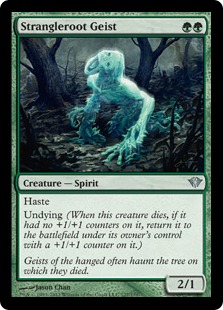
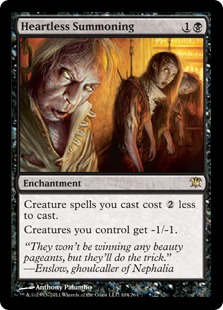
What would you sleeve up
alongside this one?
#11. Deck Archetypes - Aggro
Magic has always had its three main deck archetypes: aggro, combo, and control. These are fluid to say the least - a deck can easily include elements of multiple archetypes, and often will - but they offer a good way of thinking about how a well-optimised deck intends to defeat its opponent, and a good source of inspiration. In the next few sections I'll detail the three core archetypes and a few ways in which they intermingle.
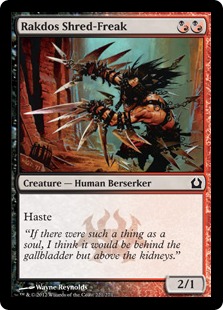
Did someone say 'Waaaagh'?
The classic aggro deck is easy to explain. As you might guess from the name, its principle is to hit the ground running and deal 20 damage to its hapless opponent as fast as is humanly possible. Aggro decks rarely head for the high end of mana costs, often topping out at a mere four mana, sometimes even three. They rely on playing good-quality cheap creatures and keeping a lot of pressure on the opponent.
Building a well-tuned aggro deck is harder than it sounds. To reliably win with an aggressive deck, you need to be able to deal with blockers and enemy removal. Your opponents may even have damage prevention or boardsweepers, neutering your attacks or killing your army. Even something as simple as a Seraph of Dawn can cause serious headaches for an aggro deck, as aggro creatures don't necessarily rise above a power of 3 unless you're exploiting synergy to buff your army, and a 2/4 with flying and lifelink could stymie your onslaught if you haven't planned for it. Once an aggro deck runs out of steam, it's suddenly on the back foot, and recovery can be difficult. Aggro decks usually lead to short games, win or lose.

A nice finisher.
Playing against aggro can be equally difficult. Don't be afraid to buy yourself time with whatever you have at your disposal; choose your removal targets wisely. If you're deckbuilding to fight aggro, try making use of defensive cards that don't suffer combat damage, like Fog Bank and Guard Gomazoa. These are fantastic blockers and will be a thorn in the side of your opponent, potentially drawing removal away from your more valuable cards in the process. Failing those, defenders such as Angelic Wall are almost as good, and you always have the option of tapping their attackers down with Downpour, making their attacks useless (or even deadly for them) with Safe Passage and Fog, or just straight-up destroying everything with your boardsweeper of choice (try Blasphemous Act). These are tools that any slower deck should consider using, and they're invaluable when someone tries to rush you.
#12. Deck Archetypes - Combo
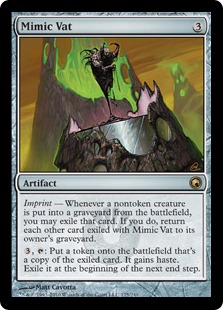
It only does everything.
The most obvious example of combo play is the 'infinite combo'. This is an interaction between cards that, after some time, resets itself and leaves you with slightly more of something than you had when you started, allowing you to perform it repeatedly on loop to generate theoretically-infinite amounts of a resource. Fortunately, the game allows you to declare 'I do this one billion times' rather than having to perform each iteration by hand, provided that you can actually halt the loop.
A good example of an infinite loop is the Myr Galvanizer infinite mana combo, which happens to be demonstrated in this LoadingReadyRun video at around 1:20. By repeatedly tapping and untapping a group of myr, you can generate as much mana as you want,

Here are some game-ending infinite combos I've used or come up with, as examples. Don't be afraid to use Gatherer or other resources if you can't figure out why they work; most combos are pretty weird in terms of rules interactions.
- Peregrine Drake/Ghostly Flicker/Archaeomancer (infinite mana loop; notable for the fact that you can buy four of each card for £2 total)
- Sun Titan/Unhallowed Pact/Bloodflow Connoisseur (sacrifice the Sun Titan an infinite number of times for fun and profit)
- Thraben Doomsayer/2 Midnight Guard/Clock of Omens/Mycosynth Lattice (infinite 1/1 human tokens)
- The Myr Galvanizer loop above (infinite mana)
- Kiki-Jiki, Mirror Breaker or Splinter Twin with Pestermite or Deceiver Exarch (infinite token copies of the blue creature, with haste)
- Sanguine Bond/Exquisite Blood (if you gain life or anyone else loses any... they all die)
Combo decks tend to have rather high deckbuilding costs. To pull off the combo effectively, you need to draw the right cards at the right times, protect them (and yourself) while the combo is set up, and cover up the combo's weaknesses so as to get the most out of it. To use the Myr Galvanizer example, you need to be able to protect your myr from removal, prevent yourself from dying while you play mana-generators for five turns, ensure you have a Fireball or other kill card ready for when the combo goes off, and so on. All this puts a pretty strain on the rest of your deck if you want to use the combo as a reliable win condition. Non-infinite combos tend to have a bit of an easier time of it, as in my experience they normally exploit synergy in order to do battle with the opponent as opposed to set up some kind of apocalyptic final turn out of nowhere.
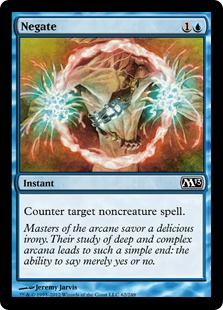
Counterspells and removal of your own are a great help. Second Guess and Negate make great anti-counterspell counterspells, cards like Disentomb allow you to pull key pieces back out of the graveyard if they get killed, and giant boardsweepers or mass tapping effects like Sleep keep creatures out of your hair while you set up. And don't forget your card drawing! Creatures like Elvish Visionary can both block and help filter through your library, Tandem Lookout allows you to draw cards repeatedly, and Divination just gives you cards, no fuss. The more cards you draw, the more likely you are to draw your combo pieces, and the more answers you'll have for your opponent's threats. Which leads us on to...
#13. Deck Archetypes - Control
If aggro is interaction with your opponent's deck through attacking, and combo is through defence, what's control? Control is interaction through denial. By countering spells, destroying creatures, preventing damage and otherwise systematically removing your opponent's options, you leave her unable to win. By drawing cards and casting the right spells, you gradually accrue card advantage over your opponent, granting yourself a greater set of options and the upper hand in any game of attrition.
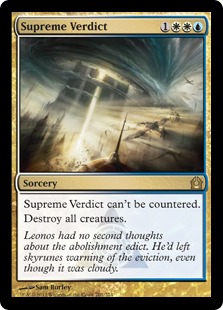
Control decks are easier to put together than combo decks simply because you don't have to come up with a viable combo; ostensibly, you can chuck a load of counterspells and/or removal into any old blue/white deck and it ought to turn out control-ish. Making a good control deck capable of dealing with anything your opponent throws at it, however, is much harder. Control decks are also arguably more difficult to play than many others; you have to be able to judge when and where to use each tool at your disposal. They're great for developing your skill both as a deckbuilder and a player, and very different from the sort of deck most new players put together. Give one a shot - you might be surprised.
Most control decks run some combination of blue, white and black. Blue has the most "tempo" cards, i.e. cards that buy you time, such as counterspells and cards like Mist Raven. These allow a player to control the flow of the game and deal with threats in a slightly more general way than the other colours - there are far fewer ways to avoid being hit with a blue answer spell than those of any other colour. For instance, pretty much nothing besides being hexproof will save a creature from an Unsummon, and very, very few cards in the entire game are immune to Cancel. The downside is that these spells require good timing and forethought to be particularly effective. Blue also has access to a lot of flying or unblockable creatures, which you don't need many of to be dealing damage every turn. White and black supply excellent removal for things that are already on the board, including boardsweepers, and all sorts of nasty tricks, from damage prevention to draining life off your opponent whenever something dies. They also have a lot of very good, usually flying, large creatures (typically demons and angels) that can give a deck its top end, and there are some excellent blue-white cards out there, especially with the release of Return to Ravnica.
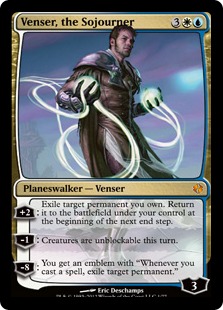
Notably, neither deck includes a single counterspell. A few other ways to control your opponent include massed removal (often mono-black), the aforementioned counterspells, "hand attack" (making your opponent discard cards), the detain mechanic, repeatedly tapping opposing creatures...
Fighting control decks can be difficult at first. Speed is always helpful. If you're having trouble with control, look around for good creatures at the cheap end of the mana curve (up to around three), especially ones with undying, regenerate or (best of all) hexproof, which are a huge pain for your opponent to lock down. Young Wolf and Strangleroot Geist are good examples. Lightning Greaves is a really handy piece of equipment that'll be a lovely thorn in the side of your opponent - imagine if you played that on the second turn and dropped an uncounterable, discard-proof, oversized Loxodon Smiter on turn 3, gave it shroud and haste, and started swinging!
Against a counterspell-heavy control deck, remember that at some point your opponent will stop drawing them, or not leave enough mana open to cast something. Try and fake him out by holding on to your more powerful cards (or pretending to!) until you get an opening. If he keeps counterspells back for what he fears is in your hand, regardless of whether it's a couple of spare lands or a huge dragon, you can use that to sneak cheaper, less deadly creatures onto the board; if not, you can absorb Cancels with Gore-House Chainwalkers all day until his supply runs dry. Against discard or heavy removal, a similar thing applies - if he somehow has a discard spell/removal spell/counter/whatever for every single card you have, he won't have anything he can use to actually win the game.
Finally, look back at section #7: don't forget removal! If your opponent is only attacking you with a single Latch Seeker, chucking a Tragic Slip at it can shut down his offence, buying you time to hit back.
Be patient, and try to learn not to rely on any one card too much, even if it's your favourite one; the nature of Magic is that your single Ancient Hellkite will die without doing anything half the time. (Think of it like this: If it didn't, the game would be imbalanced, because most cards that cost six or more mana - especially rare ones - are designed to be potentially game-winning bombs, since it takes so much effort or time to get them out. Were it not for removal, the game would become a race to see who gets to play their huge creature first, and that'd get pretty dull pretty quickly. Conversely, if these huge monsters weren't quite so bomb-y, they wouldn't be anywhere near as fun or worth the effort to play. When that Ancient Hellkite hits the board and sticks, it'll happily destroy both your opponent and her army by itself in a few turns.)
#14. Mixing Archetypes
So - there's your overview of the three core deck archetypes people talk about in Magic. But, of course, the reality is far less tripartite, and most decks will overlap between them somewhat. Here are a few examples of recently popular deck types, which also ought to double as inspiration.
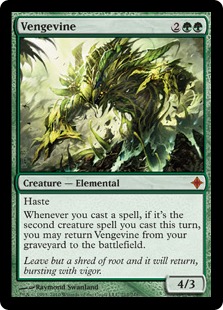
This thing is a Combo/Aggro
mix all by itself.
- Ramp (Combo/Aggro): Generate lots of mana very quickly using mana acceleration cards, use that to summon huge creatures, and overwhelm the opponent.
- Reanimator (Combo/Aggro or Combo/Control): Find a way to dump some large, implausibly expensive creature (say, Griselbrand) from your hand or deck into your graveyard, then dump it right back out again and onto the battlefield with something like Unburial Rites. Proceed to lay the righteous smack down. Reanimation combos are relatively lightweight - they don't eat that much of your deck - so a good reanimator deck will also be able to fight its opponent normally in some other way, so as to buy time for the combo to go off and as insurance if your opponent drops a Grafdigger's Cage.
- Azorius beatdown (Aggro/Control): Spam creatures with detain, protection, and other nice abilities to lock down your opponent with the very same creatures whacking them in the life total.
- Miracles (Combo/Control): Exploit Avacyn Restored's miracle mechanic with clever use of card-drawing, keeping your opponent off the board with huge spells cast for very little mana, before casting a massive Entreat the Angels as a finisher.
- Delver (Aggro/Control): Arguably the dominating deck of Scars of Mirrodin/Innistrad Standard tournaments, this deck (whose signature card was Delver of Secrets) repeatedly cast cheap card-drawing spells in order to accrue card advantage (or choose what it wanted in its hand) at a frightening pace, while simultaneously attacking every turn with flying creatures and shutting down responses with Mana Leak and removal. Nasty.

Comments